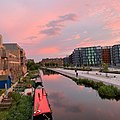Industrialisation
The character of the district was to change in the 19th century, when it was transformed from a "secluded residential area for the middle classes" into the city's main industrial district. In 1822, it became the eastern terminus of the Union Canal, which ran from Edinburgh to Falkirk. The canal originally ended at the twin basins of Port Hopetoun and Port Hamilton, named after the canal company's principal backers. These were infilled in 1922, however, and the waterway now stops short at Lochrin Basin. [5] The Leamington Lift Bridge, installed in 1906, stands at the entrance to the basin. [6]
In 1856, the former Castle Silk Mills in Fountainbridge became the headquarters of the North British Rubber Company, manufacturers of Wellington boots and other rubber goods. The company was to become one of the biggest employers in the area over the ensuing century. During the Second World War, the rubber mills employed 9,000 workers and operated 24 hours a day. [7] The company was bought out by Uniroyal in 1966, and the new owners began relocating operations to Newbridge on the outskirts of the city. The last facility at the Castle Mills site, a hose factory, closed in 1973. [8]
Another major employer in Fountainbridge was McEwan's, which opened its Fountain Brewery here in 1856. By 1889, the site had grown to cover 12 acres (4.9 ha) and the company was valued at £1 million. McEwan's merged with Younger's to form Scottish Brewers in 1931, which in turn became the Scottish & Newcastle company in 1960. [9] In 1973, the company invested £13 million in a state-of-the-art brewery at the old Castle Mills. The new brewery continued to operate until 2004. [9]
By the mid-20th century, much of the housing stock in Fountainbridge and other working-class areas of the city had degraded into slums. Labour leader Harold Wilson visited the district in 1964 and expressed shock at the poor conditions in which residents were living. The Council responded to the problem by initiating a series of slum clearance programmes. Between 1950 and 1973, some 16,556 houses were closed or demolished and some 35,237 people were evicted across the city.
Redevelopment
Redevelopment of Fountainbridge began in 1998 with the construction of the Fountain Park leisure centre on former brewery ground on the north side of Dundee Street. This multi-purpose complex includes an adventure golf course, a laser tag arena, an amusement arcade, a multiplex cinema and ten-pin bowling, alongside multiple food outlets.
The Fountain Brewery site ceased operations in 2004 and was bought by the Council in 2012. [13] The new Boroughmuir High School opened here in 2018. [14] [15] A remnant of the Castle Mills complex that the brewery had used as an office was leased to the Edinburgh Printmakers at a nominal rent. [16] The building underwent an extensive renovation and opened in 2019 as a "multi-use arts complex centred around printmaking production". [17] [18] The rest of the site is earmarked for homes, offices, and shops. [19]
Edinburgh Quay on the Union Canal is now the home of the annual Edinburgh Canal Festival. [20] [21] Scottish Canals offers long-term berths on the canal as part of its "Living on Water" programme. [22]









